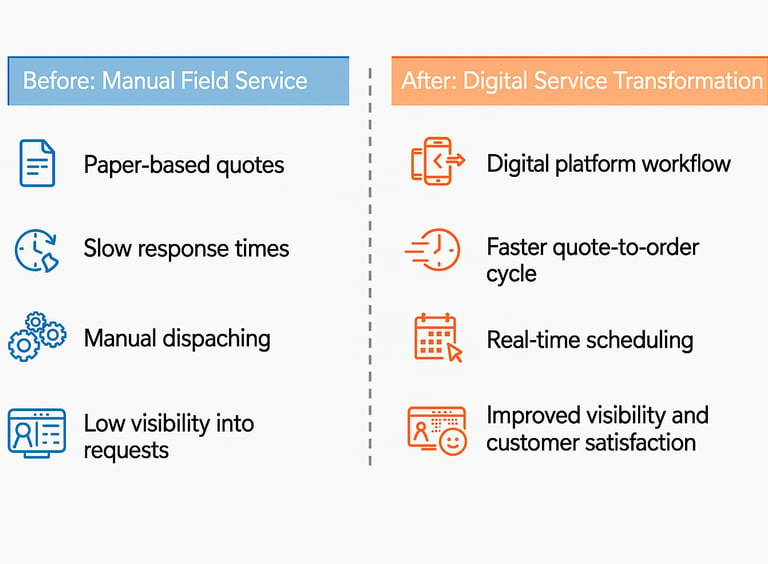How an HVAC Manufacturer Transformed Its Field Service Strategy to Help Businesses Return to Office Safely
Mihir Joshi


Based on my direct experience working with global HVAC manufacturers, this case study highlights how field service teams adapted their strategy to enable a safe return to office for millions of employees. These lessons are drawn from real projects I’ve been involved in, anonymized to protect client confidentiality.
Context
Before COVID-19, this global HVAC manufacturer was pursuing a field service optimization initiative - standardizing processes, improving technician utilization, and increasing installed base visibility.
But as workplaces shut down, customer needs changed overnight. The conversation shifted from service efficiency to air quality, safety, and compliance. Organizations urgently sought HVAC partners who could deliver rapid, reliable solutions to enable a safe return to physical offices.
Rather than delaying transformation, the manufacturer made a bold pivot - repurposing its service strategy to meet emerging customer needs.
The Business Challenge
The company’s planned service optimization roadmap focused on efficiency and cost reduction no longer fit the new reality.
Customers demanded fast turnaround, flexible contracts, and proof of indoor air quality improvements. But the manufacturer faced several pain points:
Lack of visibility into real-time service needs across customer sites
Manual quoting and coordination, which slowed responses
Disrupted field operations, with dispatchers and technicians balancing emergency retrofits and ongoing maintenance
Revenue uncertainty as planned optimization projects stalled
The challenge was clear: how to rapidly reorient field service operations around customer safety needs without derailing long-term digital goals.
The Approach
Instead of continuing its pre-pandemic roadmap, the manufacturer redirected its efforts toward building a custom digital service platform.
The platform allowed clients, technicians, and dispatchers to request, quote, and manage “return-to-office” solutions through a unified interface. Air quality assessments, filter upgrades, and compliance retrofits could now be configured, priced, and scheduled digitally - cutting days from the response cycle.
While the initial idea emerged from the field service transformation team, it quickly gained traction across functions. Service, product, and IT leaders collaborated informally to accelerate development, balancing innovation speed with system stability.
The team leveraged existing service data and workflows for rapid configuration, avoiding the need to start from scratch. Within months, the new solution was live and operational.
The Outcome
The results were transformative. Within months, the company had enabled hundreds of commercial sites to reopen safely, supporting millions of employees’ return to offices worldwide.
Beyond immediate impact, the shift delivered strategic benefits:
New service revenue streams emerged from bundled “return-to-office” offerings
Faster quote-to-order cycles, enabled by digital workflows
Higher customer satisfaction, driven by transparency and responsiveness
Improved internal visibility into installed base performance and air quality-related service demand
Most importantly, the company repositioned itself as a trusted service-led partner, not just an equipment provider.


Before and after: How digital field service transformation streamlined workflows, improved visibility, and accelerated return-to-office solutions for HVAC customers
Lessons for Others
This story offers practical takeaways for manufacturers and service organizations navigating transformation in uncertain times:
Adapt strategy to context. A well-planned initiative can quickly lose relevance- agility is the real competitive advantage.
Build around customer outcomes, not internal KPIs. The pivot succeeded because it focused on solving customer problems first.
Technology flexibility matters. Rapid configuration and modular design allowed the team to deliver quickly without a full system rebuild.
Empower your field teams. With digital tools and contextual insights, technicians became trusted advisors to clients navigating new safety standards.
Think long-term even during crisis. What started as a short-term response laid the foundation for a recurring service revenue model.
If you’re looking to reimagine your field service operations for customer-centric outcomes, my experience working with global manufacturers can guide your strategy.
Reach out to learn more.
Author Info
Written by Mihir Joshi
After 15 years working with leading manufacturers, I created SmartServiceOps to share practical insights for the field service industry.
